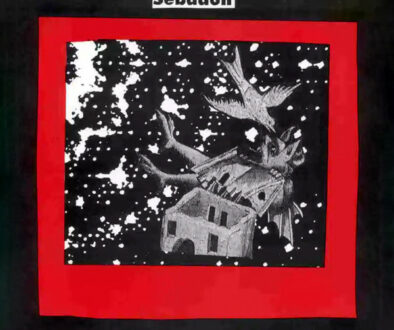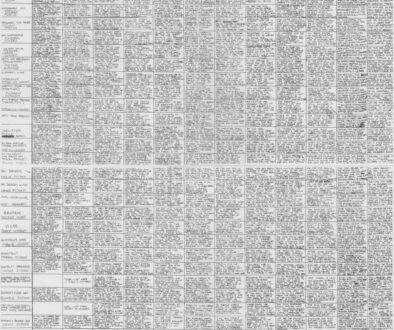His Madness Keeps Him Sane (Book Three, Part 37: Crazy Jane and Truddi Chase)
Previously in The Last War in Albion: Morrison’s take on Doom Patrol interpolated avant garde influences such as experimental film and Dada, the latter in an arc in which the Doom Patrol confronts the Brotherhood of Dada and the Fifth Horseman of the Apocalypse.
“He’s not mine, is he? His madness… his madness keeps him sane.” – Neil Gaiman, Sandman

The resolution of the Brotherhood of Dada arc saw Jane rendered comatose following her confrontation with the Fifth Horseman of the Apocalypse, setting up a one-off called “Going Underground” in which Cliff enters her mind to try to bring her back. This sets up Morrison’s first substantial exploration of Jane’s psychology, with her inner landscape given an elaborate depiction as a subway system with stops for the each of her alters, with a repeated motif of puzzle pieces throughout. As he travels through this landscape, guided by Driver 8, the system’s conductor, he comes to understand how Jane got to be this way, discovering things like the station for Miranda, who had been the front personality before Jane, working as a graphic designer in Metropolis before encountering some trauma and destroying herself at “the well” within the Underground. Driver 8 fears that Jane has gone to the well to do the same, which would leave the entire system trapped in a body nobody feels able to manage full time. Eventually Cliff makes his way to the well and is able to rescue Jane from what dwells within, which turns out to be Daddy, an alter representing Jane’s terrified memories of her abusive father, which Cliff helps her fight off and restore herself.

More than perhaps any other moment of Morrison’s early career, this is an issue full of both exhilarating triumphs and appalling failures, a statement that by and large applies to their handling of Crazy Jane in general. On one level, Morrison’s handling of Jane is careful, nuanced, and well-researched. In the late 80s and early 90s the trend when talking about what was then clinically called multiple personalities disorder, but would soon be renamed dissociative identity disorder, was largely exploitative and sensationalistic. Plural systems were generally treated as something to stare at on talk shows, or to allow actresses (and it was always actresses) to win awards for playing “difficult” roles in enthusiastically lurid films like The Three Faces of Eve or Sybil. In contrast, as her first scene demonstrates, Morrison starts from a position of compassion and empathy for Crazy Jane, generally treating her not as an exotic object to put on display, but as a human being, albeit a very unusual one. In many ways the clearest manifestation of this is “Going Underground” itself, which, for all that it’s long on fantastical imagery, is first and foremost an attempt to depict Crazy Jane’s interiority on its own terms, a remarkable goal and approach to the subject matter.
And Morrison’s treatment of multiplicity has a lot to recommend it, especially in the context of the time it was published. Most notably, Morrison declines to treat Jane as a problem to be solved. Her multiplicity causes her difficulty at various times, yes, but it is also the source of her powers and the reason she’s in the Doom Patrol, and there is no serious discussion of “curing” Jane. More presciently, the end of Morrison’s run sees Jane pointedly refuse to integrate her personalities. This stands in marked contrast to standard psychiatric views, which hold that integrating all of the personalities of a given plural system is the only path towards healing, a viewpoint that is adamantly rejected by numerous plural systems who argue that this is often destructive and counterproductive. In having Jane instead come to an internal agreement to cooperate, which she describes as “like seeing the world from every angle at the same time,” Morrison seizes an immensely forward-thinking position in line with plural advocates. Indeed, Morrison has Jane quote Chaos Magick pioneer Peter Carroll, saying that “Sanity is a state in which our component selves love and trust each other, and are prepared to let each other assume control as circumstances demand,” a statement with genuine radicalism.
And yet there are problems evident in this as well. Morrison is coming perilously close to fetishizing multiplicity, a concern that’s amplified by their comment in their annotations to the part of the Arkham Asylum in which they propose the idea that the Joker possesses a form of “super-sanity” that offers “a brilliant new modification of human perception, more suited to urban life at the end of the twentieth century.” Morrison, in annotations, suggests that this idea “eventually developed into my theories of multiple personality complexes as the next stage in human consciousness development,” a viewpoint that tips troublingly into a weird objectification that is in many ways just the “freak show” approach to depicting multiplicity except with exoticized hero worship in place of lurid disgust. And this is part and parcel of what Morrison is doing by putting Jane in the book in the first place. Doom Patrol was, after all, always an ostentatious and over the top book that reveled in the spectacle of its content, and the presence of a high concept character like Crazy Jane was unmistakably part of that—an element to be listed along with the dual-gendered Rebis and the Brotherhood of Dada and Dorothy Spinner and all the rest while enthusiastically describing how amazingly weird this comic is. Crazy Jane is unmistakably on display in the book, even if it’s a more approving portrayal than most.

Morrison makes other missteps as well, however. For all that “Going Underground” focuses on Jane’s interiority, it still makes the all too common mistake of reducing her to a puzzle to be solved—an impression that’s literalized by the recurrent motif of puzzle pieces. This gets explained within the narrative by a flashback to the young Kay Challis working on a jigsaw puzzle when her father comes to rape her, but it still serves to position that reveal as some sort of “solution” to Jane, a move that in turn serves to reduce her to the question of why she’s plural. That the answer is sexual abuse is unsurprising, and arguably avoids most of the problems of drab and destructive cliche that plague the use of sexual assault in comics—traumagenic origins for plural systems are after all common, though by no means the only type of origin. The problem is the question itself—the way in which it undermines Morrison’s sound instinct to focus on the validity of Jane’s perspective in favor of, once again, a form of objectification. And they repeat the mistake later in the comic, with an arc in which Jane discovers how Miranda came to be destroyed, which once again serves to center Jane’s identity wholly on her trauma.

The bulk of these decisions, both positive and negative, have their roots in a common origin—the source that Morrison cites in Doom Patrol #20 as their inspiration for Crazy Jane, When Rabbit Howls, which Morrison describes, in language that prefigures their objectification of Jane, as “a peek at what reality looks like from the other side.” Morrison credits the book to Trudi Chase, but in fact it describes itself as being written by The Troops for Truddi Chase, which is what Chase calls the aggregate of her ninety-three separate alters.

Chase’s book came out in 1987, and in basing a character on it in 1989 Morrison was pulling off one of the most prescient bits of trend hopping of their career—the book would surge to the best seller list the very next year on the back of an ABC miniseries and an appearance by Chase on The Oprah Winfrey Show. But in many ways more important than its media success is the fact that the book was a significant step forward in discussion of multiplicity. The fact that Morrison drew their understanding of multiples from Chase is single-handedly responsible for much of the progressiveness of their portrayal. Chase coined important terminology like “fronting” for the outwardly apparent personality and making one of the first significant arguments against integration as a necessity.
Chase’s book has also come in for no small amount of criticism. When Rabbit Howls is a complicated work with some barriers towards straightforwardly giving it credence—it is overtly fictionalized in key ways, including its decision to compress about four years of Chase’s life into nine months. Perhaps the most significant issue is the character of Marshall Fielding, presented in the text as a psychologist who Chase’s doctor repeatedly consults for insight, but who is in fact a character who exists to give voice to the Troops for Truddi Chase’s own theories on how multiplicity works, which as the book goes on begin to include the idea that plurals have psychic powers because of the enhanced levels of energy in their minds. This did little to insulate the book from the usual complaints that surround any account of DID, which is a controversial diagnosis within the psychiatric profession due to an entrenched minority of psychiatrists who dispute the validity of the diagnosis. Arguments against it vary, including rejections of the basic neurological possibility, observations of its rise in prevalence coinciding with pop culture depictions of it, or to arguments that the condition can be wholly explained by unethical and manipulative therapists, often in pursuit of the media attention that this can bring, all of which are complaints that can be made against Chase’s book specifically.
It is beyond the scope of this work to offer any sort of definitive assessment of the clinical evidence for plurality. Ultimately, such a conclusion simply does not seem feasible. The processes by which consciousness and identity emerge within the brain are ultimately unknown, which makes firm declarations of what can and cannot happen within these processes impossible. And much of the criticism seems to fall into the same trap Morrison does by putting undue importance on the question of how Crazy Jane came to be plural. Perhaps the people who experience plural consciousness were all manipulated into it by therapists or influenced by media depiction, although this seems like quite a lot of false positives. But even if this were true, it would not change the fact that plural systems have the experiences they do. Is plural consciousness caused by therapeutic malpractice somehow less real than plural consciousness caused by sexual trauma? Numerous people report having multiple distinct people within their mind, just as people have, at various points, reported sexual relationships with Selene, mystical encounters with Glycon, alien abductions, and prophetic visions. Arguments about how these things could have happened do not actually change that fact that they did.

Reading When Rabbit Howls next to Morrison’s Doom Patrol, however, reveals more fundamental problems than are apparent when taking Morrison’s treatment of Crazy Jane on face value. Simply put, Morrison went far further than just being inspired by Chase’s story, instead adapting large swaths of Chase’s actual life into the story. Several of Jane’s personalities are taken almost directly from Chase’s. Some of these are minor—Chase has an alter that’s a nun, for instance, and so Morrison gives Jane a chainsaw-wielding nun alter. Others are more significant. Black Annis, for instance, is named after a figure in English folklore, but is also a clear mirror of Chase’s Black Katherine, a similarly rage-filled and vindictive figure. And Morrison’s Butterfly Baby, who sits deep in the Underground experiencing constant and agonizing pain, is a clear mirror for the eponymous Rabbit, who exists within Chase’s system to feel pain. Even the name Crazy Jane has a clear echo in When Rabbit Howls, where one alter calls herself Crazy Mary. Another voice is called the Seventh Horseman, pointing to where Morrison got the resolution to the Brotherhood of Dada arc.

But there are larger and more significant similarities as well. Chase, for instance, calls the internal world where her non-fronting selves reside the Tunnel, a clear inspiration for Jane’s Underground. Driver 8’s reference to the overall entity as “the woman” also comes out of Chase’s terminology. Perhaps most disturbingly, the site of Chase’s childhood abuse is a farmhouse with a prominent well—the same setting that Jane’s abuse is depicted as happening in. Even the iconic line from Morrison’s first issue has its roots in When Rabbit Howls, where Chase asks her psychologist, “What do people have in their histories, Stanley, what do people have in their lives?” Taken as a whole, this goes well beyond artistic inspiration and the questions of influence that constitute most of the actual bickering between Morrison and Moore. Morrison has taken a real woman’s rape and sexual trauma and turned it into a superhero narrative with shockingly few changes. This is a gobsmacking ethical lapse—an absolutely inexcusable decision that taints the entire handling of Crazy Jane.
Is this enough to render Crazy Jane a fatally flawed character? Perhaps, although ultimately it reflects worse on Morrison than on their creation. Certainly, however, it highlights the way in which Crazy Jane was a very partial triumph. What was good about her character—the mainstreaming and legitimization of plurality and the humanity and compassion with which she is depicted—ultimately sits alongside a strand of objectification and fetishization that runs far deeper than just the character and into the extraordinary woman who inspired her.





February 11, 2022 @ 1:47 am
This made me stop and think. My first reaction was “oh, come on” — and I confess that was driven in part by the fact that I like Crazy Jane and I absolutely love this particular story. But upon consideration, yeah, you have a point. Morrison could at least have filed off the serial numbers. Who knows what Truddi Chase would have thought of this — but it doesn’t really matter; she wasn’t asked.
Speaking of which: I read When Rabbit Howls when it first came out, and was transfixed up until the point where Truddi starts demonstrating psychic powers. That was a throw-the-book moment for young me. I viewed psi powers as the province of gulls and charlatans (I still do), and Chase claiming she had them prompted a visceral reaction: okay, she’s lying about this, which means she’s probably lying about everything. In retrospect, the psi stuff is forgivable, but the book is still kind of a hot mess, with fictional aspects grafted on to what’s supposed to be a more or less factual retelling. If there’s a more recent equivalent, I’d be interested to read it; brief googling doesn’t show one.
Doug M.
February 11, 2022 @ 3:51 am
Meanwhile: I’m a bit surprised that you jumped right over this issue’s climactic scene, where Cliff can only access Jane’s core persona by stripping naked and showing that he’s genderless.
“I’m /not/ a man! Not any more. It was all burned or ripped away or amputated… I’m not a man.”
This is an incredibly powerful and moving scene at multiple levels. Just for starters, consider what it says about Cliff’s development as a character; it was just a few issues earlier that he was saying “Sometimes I see a woman and I just want to…” Over 40 issues, Morrison very explicitly shows Cliff moving from a toxic form of masculinity to a much more benign one — but the beginning point of this is an act of horrific violence, “crushed or burned or torn away”. The Chief will actually make this explicit: when Cliff was whole, he was just another asshole male celebrity. Destroying his human body allowed him to develop real humanity: he’s a better man now than he was when he was a man. The end point of this arc will come when Cliff rejects a new human body… but that’s a bit down the line.
the gender stuff! Rebis is a hermaphrodite, Jane is both sexless and hypersexual, Cliff… oh, man. This stuff is 30+ years old, but knowing that Morrison was struggling to conceptualize his queerness makes it even richer in retrospect.
Meanwhile, just a few scattered thoughts about that scene:
— an agendered individual being able to accomplish what a male could not
— journey to the Underworld: is this explicitly a part of a Hero’s Journey for Cliff?
— Cliff’s Virgil through this Underworld is Driver 8, who also appears to be agender
— Driver 8, name taken from an R.E.M. song about stress and isolation (and character not a Truddi Chase ripoff afaicr)
— as in Dante, at the bottom of Hell there’s a monstrous evil giant. Dante’s Satan chews on sinners; Daddy grabs Cliff and bites him in two. (Also, the issue’s cover kind of gives it away.)
— Cliff’s Christlike offer of self-sacrifice: “Take me instead of her, you bastard!”
— solidarity and understanding among victims of violence
— character stripping full-frontal naked in a mainstream comic (but it’s okay because robot)
and so much more!
Also, Cliff spends the whole issue trying to rescue Jane in what seems like a very standard male hero-rescues-female-victim story. But in the last couple of pages, the trope inverts; Cliff is helpless against Daddy, he’s defeated almost instantly, and it’s Jane who has to defeat the monster and rescue him.
What could have been a simple story about The Power of Friendship becomes, in Morrison’s hands, something incredibly rich and strange. It’s an amazing issue by itself, but it also resonates deeply with the rest of Morrison’s run, and beyond.
Doug M.
P.S. Case’s art on this! The creepy posters on the Underground walls! Brush Without Fear… wth?
February 14, 2022 @ 6:46 am
It is worth pointing out that the idea that Cliff is genderless because he lost his body is very biologically essentialist and points to the more problematic aspects of Morrison’s grappling with gender stuff.